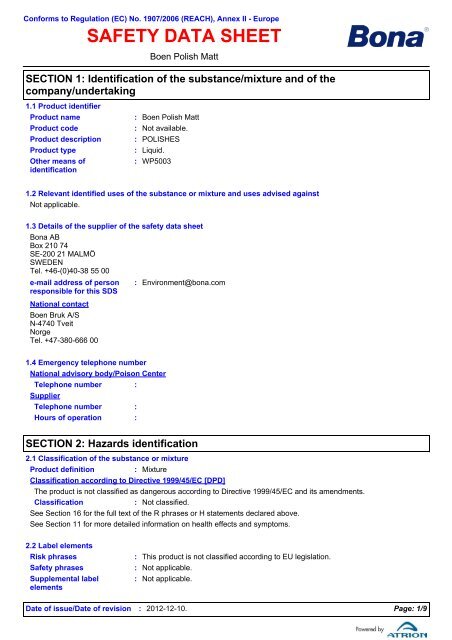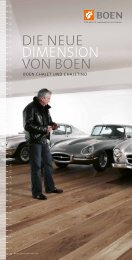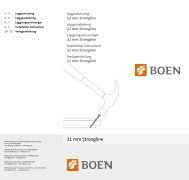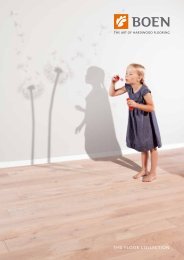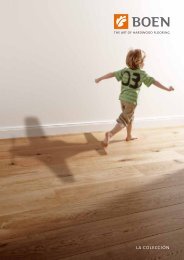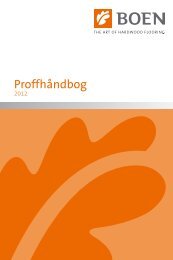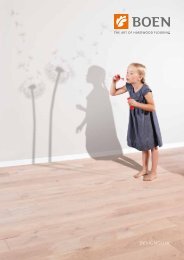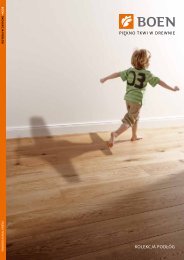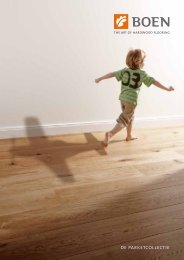Safety Data Sheet Polish Matt - Boen
Safety Data Sheet Polish Matt - Boen
Safety Data Sheet Polish Matt - Boen
Create successful ePaper yourself
Turn your PDF publications into a flip-book with our unique Google optimized e-Paper software.
Conforms to Regulation (EC) No. 1907/2006 (REACH), Annex II - Europe<br />
1.1 Product identifier<br />
Product name<br />
Other means of<br />
identification<br />
SAFETY DATA SHEET<br />
:<br />
:<br />
<strong>Boen</strong> <strong>Polish</strong> <strong>Matt</strong><br />
SECTION 1: Identification of the substance/mixture and of the<br />
company/undertaking<br />
Product type :<br />
<strong>Boen</strong> <strong>Polish</strong> <strong>Matt</strong><br />
Product code : Not available.<br />
Product description : POLISHES<br />
Liquid.<br />
WP5003<br />
1.2 Relevant identified uses of the substance or mixture and uses advised against<br />
Not applicable.<br />
1.3 Details of the supplier of the safety data sheet<br />
Bona AB<br />
Box 210 74<br />
SE-200 21 MALMÖ<br />
SWEDEN<br />
Tel. +46-(0)40-38 55 00<br />
e-mail address of person<br />
responsible for this SDS<br />
National contact<br />
<strong>Boen</strong> Bruk A/S<br />
N-4740 Tveit<br />
Norge<br />
Tel. +47-380-666 00<br />
1.4 Emergency telephone number<br />
National advisory body/Poison Center<br />
Telephone number<br />
Supplier<br />
Telephone number :<br />
Hours of operation :<br />
Risk phrases<br />
: Environment@bona.com<br />
SECTION 2: Hazards identification<br />
2.1 Classification of the substance or mixture<br />
Product definition : Mixture<br />
Classification according to Directive 1999/45/EC [DPD]<br />
<strong>Safety</strong> phrases : Not applicable.<br />
:<br />
The product is not classified as dangerous according to Directive 1999/45/EC and its amendments.<br />
Classification : Not classified.<br />
See Section 16 for the full text of the R phrases or H statements declared above.<br />
See Section 11 for more detailed information on health effects and symptoms.<br />
2.2 Label elements<br />
Supplemental label<br />
elements<br />
:<br />
This product is not classified according to EU legislation.<br />
: Not applicable.<br />
Date of issue/Date of revision : 2012-12-10.<br />
Page: 1/9
<strong>Boen</strong> <strong>Polish</strong> <strong>Matt</strong><br />
SECTION 2: Hazards identification<br />
Special packaging requirements<br />
Containers to be fitted<br />
with child-resistant<br />
fastenings<br />
Other hazards which do<br />
not result in classification<br />
:<br />
Not applicable.<br />
Tactile warning of danger : Not applicable.<br />
2.3 Other hazards<br />
:<br />
Not available.<br />
SECTION 3: Composition/information on ingredients<br />
Substance/mixture : Mixture<br />
There are no ingredients present which, within the current knowledge of the supplier and in the concentrations<br />
applicable, are classified as hazardous to health or the environment, are PBTs or vPvBs or have been assigned a<br />
workplace exposure limit and hence require reporting in this section.<br />
SECTION 4: First aid measures<br />
4.1 Description of first aid measures<br />
General : In all cases of doubt, or when symptoms persist, seek medical attention. Never give<br />
anything by mouth to an unconscious person. If unconscious, place in recovery<br />
position and seek medical advice.<br />
Eye contact<br />
Inhalation<br />
Skin contact<br />
Ingestion<br />
See toxicological information (Section 11)<br />
:<br />
:<br />
:<br />
:<br />
Check for and remove any contact lenses. Immediately flush eyes with running water<br />
for at least 15 minutes, keeping eyelids open. Seek immediate medical attention.<br />
Remove to fresh air. Keep person warm and at rest. If not breathing, if breathing is<br />
irregular or if respiratory arrest occurs, provide artificial respiration or oxygen by<br />
trained personnel.<br />
Remove contaminated clothing and shoes. Wash skin thoroughly with soap and<br />
water or use recognized skin cleanser. Do NOT use solvents or thinners.<br />
If swallowed, seek medical advice immediately and show this container or label.<br />
Keep person warm and at rest. Do not induce vomiting.<br />
Protection of first-aiders : No action shall be taken involving any personal risk or without suitable training.<br />
4.2 Most important symptoms and effects, both acute and delayed<br />
There are no data available on the preparation itself. The preparation is not classified as dangerous according to<br />
Directive 1999/45/EC and its amendments.<br />
Repeated or prolonged contact with the preparation may cause removal of natural fat from the skin, resulting in nonallergic<br />
contact dermatitis and absorption through the skin.<br />
If splashed in the eyes, the liquid may cause irritation and reversible damage.<br />
4.3 Indication of any immediate medical attention and special treatment needed<br />
Notes to physician : Treat symptomatically. Contact poison treatment specialist immediately if large<br />
quantities have been ingested or inhaled.<br />
Specific treatments<br />
:<br />
No specific treatment.<br />
SECTION 5: Firefighting measures<br />
5.1 Extinguishing media<br />
Suitable extinguishing<br />
media<br />
Unsuitable extinguishing<br />
media<br />
:<br />
:<br />
Recommended: alcohol-resistant foam, CO2, powders, water spray.<br />
Do not use water jet.<br />
Date of issue/Date of revision : 2012-12-10.<br />
Page: 2/9
<strong>Boen</strong> <strong>Polish</strong> <strong>Matt</strong><br />
SECTION 5: Firefighting measures<br />
5.2 Special hazards arising from the substance or mixture<br />
Hazards from the<br />
substance or mixture<br />
Hazardous thermal<br />
decomposition products<br />
5.3 Advice for firefighters<br />
Special protective actions<br />
for fire-fighters<br />
Special protective<br />
equipment for fire-fighters<br />
:<br />
:<br />
:<br />
:<br />
Fire will produce dense black smoke. Exposure to decomposition products may<br />
cause a health hazard.<br />
Decomposition products may include the following materials: carbon monoxide,<br />
carbon dioxide, smoke, oxides of nitrogen.<br />
Cool closed containers exposed to fire with water. Do not release runoff from fire to<br />
drains or watercourses.<br />
Appropriate breathing apparatus may be required.<br />
SECTION 6: Accidental release measures<br />
6.1 Personal precautions, protective equipment and emergency procedures<br />
For non-emergency : Exclude sources of ignition and ventilate the area. Avoid breathing vapor or mist.<br />
personnel<br />
Refer to protective measures listed in sections 7 and 8.<br />
For emergency responders :<br />
6.2 Environmental<br />
precautions<br />
6.3 Methods and materials<br />
for containment and<br />
cleaning up<br />
6.4 Reference to other<br />
sections<br />
SECTION 7: Handling and storage<br />
:<br />
:<br />
:<br />
If specialised clothing is required to deal with the spillage, take note of any<br />
information in Section 8 on suitable and unsuitable materials. See also Section 8 for<br />
additional information on hygiene measures.<br />
Do not allow to enter drains or watercourses. If the product contaminates lakes,<br />
rivers, or sewers, inform the appropriate authorities in accordance with local<br />
regulations.<br />
Contain and collect spillage with non-combustible, absorbent material e.g. sand,<br />
earth, vermiculite or diatomaceous earth and place in container for disposal<br />
according to local regulations (see section 13). Preferably clean with a detergent.<br />
Avoid using solvents.<br />
See Section 1 for emergency contact information.<br />
See Section 8 for information on appropriate personal protective equipment.<br />
See Section 13 for additional waste treatment information.<br />
The information in this section contains generic advice and guidance. The list of Identified Uses in Section 1 should be<br />
consulted for any available use-specific information provided in the Exposure Scenario(s).<br />
7.1 Precautions for safe<br />
handling<br />
7.2 Conditions for safe<br />
storage, including any<br />
incompatibilities<br />
7.3 Specific end use(s)<br />
:<br />
:<br />
Avoid contact with skin and eyes. Avoid inhalation of vapor, spray or mist.<br />
Eating, drinking and smoking should be prohibited in areas where this material is<br />
handled, stored and processed.<br />
Put on appropriate personal protective equipment (see Section 8).<br />
Never use pressure to empty. Container is not a pressure vessel.<br />
Always keep in containers made from the same material as the original one.<br />
Comply with the health and safety at work laws.<br />
Store in accordance with local regulations.<br />
Notes on joint storage<br />
Keep away from: oxidizing agents, strong alkalis, strong acids.<br />
Additional information on storage conditions<br />
Observe label precautions. Store in a dry, cool and well-ventilated area. Keep away<br />
from heat and direct sunlight.<br />
Keep container tightly closed.<br />
No smoking. Prevent unauthorized access. Containers that have been opened must<br />
be carefully resealed and kept upright to prevent leakage.<br />
Date of issue/Date of revision : 2012-12-10.<br />
Page: 3/9
<strong>Boen</strong> <strong>Polish</strong> <strong>Matt</strong><br />
SECTION 7: Handling and storage<br />
Recommendations :<br />
Industrial sector specific<br />
solutions<br />
:<br />
Not available.<br />
Not available.<br />
SECTION 8: Exposure controls/personal protection<br />
The information in this section contains generic advice and guidance. The list of Identified Uses in Section 1 should be<br />
consulted for any available use-specific information provided in the Exposure Scenario(s).<br />
8.1 Control parameters<br />
Occupational exposure limits<br />
No exposure limit value known.<br />
Recommended monitoring<br />
procedures<br />
Derived effect levels<br />
No DELs available.<br />
Predicted effect concentrations<br />
No PECs available.<br />
8.2 Exposure controls<br />
Appropriate engineering<br />
controls<br />
Individual protection measures<br />
Hygiene measures :<br />
Eye/face protection<br />
Skin protection<br />
Hand protection<br />
Gloves<br />
Body protection :<br />
Respiratory protection :<br />
:<br />
:<br />
:<br />
:<br />
:<br />
If this product contains ingredients with exposure limits, personal, workplace<br />
atmosphere or biological monitoring may be required to determine the effectiveness<br />
of the ventilation or other control measures and/or the necessity to use respiratory<br />
protective equipment. Reference should be made to European Standard EN 689 for<br />
methods for the assessment of exposure by inhalation to chemical agents and<br />
national guidance documents for methods for the determination of hazardous<br />
substances.<br />
Provide adequate ventilation. Where reasonably practicable, this should be achieved<br />
by the use of local exhaust ventilation and good general extraction. If these are not<br />
sufficient to maintain concentrations of particulates and solvent vapors below the<br />
OEL, suitable respiratory protection must be worn.<br />
Wash hands, forearms and face thoroughly after handling chemical products, before<br />
eating, smoking and using the lavatory and at the end of the working period.<br />
Appropriate techniques should be used to remove potentially contaminated clothing.<br />
Wash contaminated clothing before reusing. Ensure that eyewash stations and<br />
safety showers are close to the workstation location.<br />
Use safety eyewear designed to protect against splash of liquids.<br />
Barrier creams may help to protect the exposed areas of the skin but should not be<br />
applied once exposure has occurred.<br />
For prolonged or repeated handling, use the following type of gloves:<br />
Recommended: nitrile rubber<br />
The recommendation for the type or types of glove to use when handling this product<br />
is based on information from the following source:<br />
The user must check that the final choice of type of glove selected for handling this<br />
product is the most appropriate and takes into account the particular conditions of<br />
use, as included in the user's risk assessment.<br />
Personnel should wear antistatic clothing made of natural fibers or of hightemperature-resistant<br />
synthetic fibers.<br />
Other skin protection : Appropriate footwear and any additional skin protection measures should be<br />
selected based on the task being performed and the risks involved and should be<br />
approved by a specialist before handling this product.<br />
If workers are exposed to concentrations above the exposure limit, they must use<br />
appropriate, certified respirators.<br />
Date of issue/Date of revision : 2012-12-10.<br />
Page: 4/9
<strong>Boen</strong> <strong>Polish</strong> <strong>Matt</strong><br />
SECTION 8: Exposure controls/personal protection<br />
Environmental exposure<br />
controls<br />
:<br />
Do not allow to enter drains or watercourses.<br />
SECTION 9: Physical and chemical properties<br />
9.1 Information on basic physical and chemical properties<br />
Appearance<br />
Physical state<br />
Color<br />
Odor<br />
Odor threshold<br />
pH<br />
Melting point/freezing point<br />
Initial boiling point and boiling<br />
range<br />
Flash point<br />
Vapor pressure<br />
Vapor density<br />
Relative density<br />
Solubility(ies)<br />
Liquid.<br />
White.<br />
Not available.<br />
Not available.<br />
8,7<br />
Not available.<br />
Not available.<br />
Evaporation rate : Not available.<br />
Auto-ignition temperature<br />
Not available.<br />
Flammability (solid, gas) : Not available.<br />
Burning time : Not applicable.<br />
Burning rate : Not applicable.<br />
Upper/lower flammability or<br />
explosive limits<br />
Partition coefficient: noctanol/water<br />
Not available.<br />
Not available.<br />
Not available.<br />
1,01<br />
Soluble in the following materials: cold water and hot water.<br />
Not available.<br />
Not available.<br />
Decomposition temperature : Not available.<br />
Viscosity : Not available.<br />
Explosive properties<br />
Oxidizing properties :<br />
9.2 Other information<br />
No additional information.<br />
:<br />
:<br />
:<br />
:<br />
:<br />
:<br />
:<br />
:<br />
:<br />
:<br />
:<br />
:<br />
:<br />
:<br />
:<br />
:<br />
Not available.<br />
Not available.<br />
SECTION 10: Stability and reactivity<br />
10.1 Reactivity : No specific test data related to reactivity available for this product or its ingredients.<br />
10.2 Chemical stability :<br />
10.3 Possibility of<br />
hazardous reactions<br />
Stable under recommended storage and handling conditions (see section 7).<br />
10.4 Conditions to avoid : When exposed to high temperatures may produce hazardous decomposition<br />
products.<br />
10.5 Incompatible materials :<br />
:<br />
Under normal conditions of storage and use, hazardous reactions will not occur.<br />
Keep away from the following materials to prevent strong exothermic reactions:<br />
oxidizing agents, strong alkalis, strong acids.<br />
Date of issue/Date of revision : 2012-12-10.<br />
Page: 5/9
<strong>Boen</strong> <strong>Polish</strong> <strong>Matt</strong><br />
SECTION 10: Stability and reactivity<br />
10.6 Hazardous<br />
decomposition products<br />
SECTION 11: Toxicological information<br />
11.1 Information on toxicological effects<br />
Acute toxicity<br />
Conclusion/Summary : Not available.<br />
Irritation/Corrosion<br />
Conclusion/Summary : Not available.<br />
Sensitization<br />
Conclusion/Summary : Not available.<br />
Mutagenicity<br />
Conclusion/Summary : Not available.<br />
Carcinogenicity<br />
Conclusion/Summary : Not available.<br />
Reproductive toxicity<br />
Conclusion/Summary : Not available.<br />
Teratogenicity<br />
Conclusion/Summary : Not available.<br />
: Under normal conditions of storage and use, hazardous decomposition products<br />
should not be produced.<br />
There are no data available on the preparation itself. The preparation is not classified as dangerous according to<br />
Directive 1999/45/EC and its amendments.<br />
Repeated or prolonged contact with the preparation may cause removal of natural fat from the skin, resulting in nonallergic<br />
contact dermatitis and absorption through the skin.<br />
If splashed in the eyes, the liquid may cause irritation and reversible damage.<br />
Other information : Not available.<br />
SECTION 12: Ecological information<br />
12.1 Toxicity<br />
There are no data available on the preparation itself.<br />
Do not allow to enter drains or watercourses.<br />
The preparation has been assessed following the conventional method of the Dangerous Preparations Directive<br />
1999/45/EC and is not classified as dangerous for the environment.<br />
Conclusion/Summary : Not available.<br />
12.2 Persistence and degradability<br />
Conclusion/Summary : Not available.<br />
12.3 Bioaccumulative potential<br />
Not available.<br />
12.4 Mobility in soil<br />
Soil/water partition<br />
coefficient (KOC)<br />
Not available.<br />
Mobility : Not available.<br />
12.5 Results of PBT and vPvB assessment<br />
PBT : Not applicable.<br />
vPvB : Not applicable.<br />
:<br />
Date of issue/Date of revision : 2012-12-10.<br />
Page: 6/9
<strong>Boen</strong> <strong>Polish</strong> <strong>Matt</strong><br />
SECTION 12: Ecological information<br />
12.6 Other adverse effects : No known significant effects or critical hazards.<br />
SECTION 13: Disposal considerations<br />
The information in this section contains generic advice and guidance. The list of Identified Uses in Section 1 should be<br />
consulted for any available use-specific information provided in the Exposure Scenario(s).<br />
Do not allow to enter drains or watercourses.<br />
Dispose of according to all federal, state and local applicable regulations.<br />
13.1 Waste treatment methods<br />
Product<br />
Methods of disposal :<br />
Hazardous waste :<br />
European waste<br />
catalogue (EWC)<br />
Packaging<br />
Methods of disposal :<br />
Special precautions :<br />
SECTION 14: Transport information<br />
14.1 UN number<br />
14.2 UN proper<br />
shipping name<br />
14.3 Transport<br />
hazard class(es)<br />
14.4 Packing<br />
group<br />
14.5<br />
Environmental<br />
hazards<br />
14.6 Special<br />
precautions for<br />
user<br />
Not available.<br />
Not available.<br />
-<br />
The generation of waste should be avoided or minimized wherever possible.<br />
Significant quantities of waste product residues should not be disposed of via the foul<br />
sewer but processed in a suitable effluent treatment plant. Dispose of surplus and<br />
non-recyclable products via a licensed waste disposal contractor. Disposal of this<br />
product, solutions and any by-products should at all times comply with the<br />
requirements of environmental protection and waste disposal legislation and any<br />
regional local authority requirements.<br />
Within the present knowledge of the supplier, this product is not regarded as<br />
hazardous waste, as defined by EU Directive 91/689/EEC.<br />
: The European Waste Catalogue classification of this product, when disposed of as<br />
waste, is:<br />
20 01 30 detergents other than those mentioned in 20 01 29.<br />
If this product is mixed with other wastes, this code may no longer apply. If mixed<br />
with other wastes, the appropriate code should be assigned. For further information,<br />
contact your local waste authority.<br />
Transport within<br />
user’s premises:<br />
always transport in<br />
closed containers that<br />
are upright and<br />
secure. Ensure that<br />
persons transporting<br />
the product know what<br />
to do in the event of an<br />
The generation of waste should be avoided or minimized wherever possible. Waste<br />
packaging should be recycled. Incineration or landfill should only be considered<br />
when recycling is not feasible.<br />
This material and its container must be disposed of in a safe way. Empty containers<br />
or liners may retain some product residues. Avoid dispersal of spilled material and<br />
runoff and contact with soil, waterways, drains and sewers.<br />
ADR/RID ADN/ADNR<br />
IMDG IATA<br />
Not available. Not available. Not available.<br />
Not available.<br />
Not available.<br />
-<br />
Not available.<br />
Not available.<br />
No. No. No. No.<br />
Transport within<br />
user’s premises:<br />
always transport in<br />
closed containers that<br />
are upright and<br />
secure. Ensure that<br />
persons transporting<br />
the product know what<br />
to do in the event of an<br />
-<br />
Transport within<br />
user’s premises:<br />
always transport in<br />
closed containers that<br />
are upright and<br />
secure. Ensure that<br />
persons transporting<br />
the product know what<br />
to do in the event of an<br />
Not available.<br />
Not available.<br />
Not available.<br />
-<br />
Transport within<br />
user’s premises:<br />
always transport in<br />
closed containers that<br />
are upright and<br />
secure. Ensure that<br />
persons transporting<br />
the product know what<br />
to do in the event of an<br />
Date of issue/Date of revision : 2012-12-10.<br />
Page: 7/9
<strong>Boen</strong> <strong>Polish</strong> <strong>Matt</strong><br />
SECTION 14: Transport information<br />
Additional<br />
information<br />
14.7 Transport in bulk<br />
according to Annex II of<br />
MARPOL 73/78 and the IBC<br />
Code<br />
accident or spillage.<br />
- - - -<br />
: Not available.<br />
SECTION 15: Regulatory information<br />
VOC for Ready-for-Use<br />
Mixture<br />
: Not applicable.<br />
accident or spillage. accident or spillage. accident or spillage.<br />
15.1 <strong>Safety</strong>, health and environmental regulations/legislation specific for the substance or mixture<br />
EU Regulation (EC) No. 1907/2006 (REACH)<br />
Annex XIV - List of substances subject to authorization<br />
Substances of very high concern<br />
None of the components are listed.<br />
Annex XVII - Restrictions<br />
on the manufacture,<br />
placing on the market and<br />
use of certain dangerous<br />
substances, mixtures and<br />
articles<br />
: Not applicable.<br />
Other EU regulations<br />
Europe inventory : Not determined.<br />
Black List Chemicals : Not listed<br />
Priority List Chemicals : Not listed<br />
Integrated pollution<br />
prevention and control list<br />
(IPPC) - Air<br />
Integrated pollution<br />
prevention and control list<br />
(IPPC) - Water<br />
International regulations<br />
Chemical Weapons<br />
Convention List Schedule I<br />
Chemicals<br />
Chemical Weapons<br />
Convention List Schedule II<br />
Chemicals<br />
Chemical Weapons<br />
Convention List Schedule III<br />
Chemicals<br />
15.2 Chemical <strong>Safety</strong><br />
Assessment<br />
: Not listed<br />
: Not listed<br />
: Not listed<br />
: Not listed<br />
: Not listed<br />
:<br />
This product contains substances for which Chemical <strong>Safety</strong> Assessments are still<br />
required.<br />
Date of issue/Date of revision : 2012-12-10.<br />
Page: 8/9
<strong>Boen</strong> <strong>Polish</strong> <strong>Matt</strong><br />
SECTION 16: Other information<br />
CEPE code : 8<br />
Indicates information that has changed from previously issued version.<br />
Abbreviations and acronyms : ATE = Acute Toxicity Estimate<br />
CLP = Classification, Labelling and Packaging Regulation [Regulation (EC) No.<br />
1272/2008]<br />
DNEL = Derived No Effect Level<br />
EUH statement = CLP-specific Hazard statement<br />
PNEC = Predicted No Effect Concentration<br />
RRN = REACH Registration Number<br />
Classification according to Regulation (EC) No. 1272/2008 [CLP/GHS]<br />
Not classified.<br />
Procedure used to derive the classification according to Regulation (EC) No. 1272/2008 [CLP/GHS]<br />
Not classified.<br />
Full text of abbreviated H<br />
statements<br />
Full text of classifications<br />
[CLP/GHS]<br />
Full text of abbreviated R<br />
phrases<br />
Full text of classifications<br />
[DSD/DPD]<br />
Date of printing<br />
Date of issue/ Date of<br />
revision<br />
Date of previous issue<br />
Version<br />
Notice to reader<br />
Classification Justification<br />
:<br />
:<br />
:<br />
:<br />
:<br />
:<br />
:<br />
:<br />
Not applicable.<br />
Not applicable.<br />
Not applicable.<br />
Not applicable.<br />
2012-12-10.<br />
2012-12-10.<br />
No previous validation.<br />
1<br />
The information in this SDS is based on the present state of our knowledge and on current laws. The product<br />
is not to be used for purposes other than those specified under section 1 without first obtaining written<br />
handling instructions. It is always the responsibility of the user to take all necessary steps to fulfill the<br />
demands set out in the local rules and legislation. The information in this SDS is meant to be a description of<br />
the safety requirements for our product. It is not to be considered a guarantee of the product's properties.<br />
Date of issue/Date of revision : 2012-12-10.<br />
Page: 9/9


